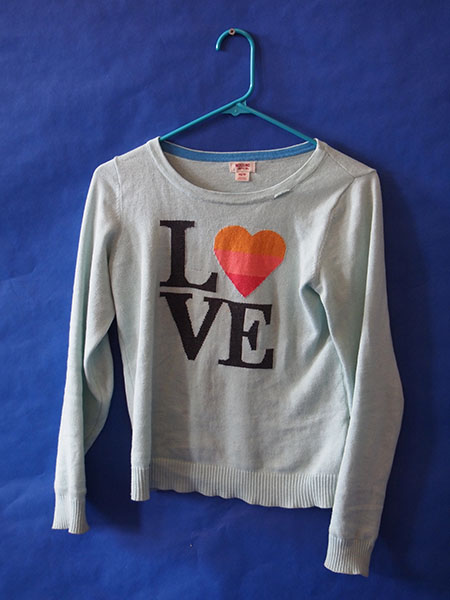![]() body | color | collections | commodity | cube | document | fabric | fetish | gender | glass | home | identity | living | machine | metal | minimal | mobility | narrative | olfactory | organic |
body | color | collections | commodity | cube | document | fabric | fetish | gender | glass | home | identity | living | machine | metal | minimal | mobility | narrative | olfactory | organic |
![]() pain | paper | plastic | plugs | power | protective | rectangular | ritual | round | sound | souvenir | spiritual | style | text-based | time | tool | touch | uniform | value | visual | warm | wood
pain | paper | plastic | plugs | power | protective | rectangular | ritual | round | sound | souvenir | spiritual | style | text-based | time | tool | touch | uniform | value | visual | warm | wood
| Clothing: Sea-foam Green Sweater with ‘LOVE’ | |||
Narrative: Mossimo Supply Co. The cotton process demands cultivators rip out weeds and grass that may compete with the cotton. Land is plowed under and soil is broken up and formed into rows. Cottonseed is planted. The boll matures in a period that ranges from 55 to 80 days. Ten weeks after flowers first appeared, fibers split the boll apart, and cotton pushes forth. The process includes seeding, picking, ginning, and baling. Samples are taken from the bales to determine the quality of the cotton. At this point the cotton plant is defoliated if it is to be machine harvested. Defoliation is often accomplished by spraying the plant with a chemical. It is important that leaves not be harvested with the fiber because they are considered "trash" and must be removed at some point. In addition, removing the leaves minimizes staining the fiber and eliminates a source of excess moisture. Some American crops are naturally defoliated by frost, but at least half of the crops must be defoliated with chemicals. Without defoliation, the cotton must be picked by hand, with laborers clearing out the leaves as they work. I purchased this sweater from Target in 2008. It traveled with me to from Queens to the Waterpod to Manhattan to Brooklyn. It was recently stained by blood from a cat's paw. |
 |
||
![]()
